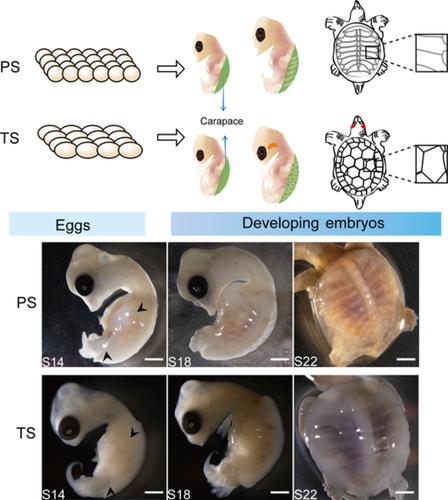当前位置:
X-MOL 学术
›
J. Morphol.
›
论文详情
Our official English website, www.x-mol.net, welcomes your
feedback! (Note: you will need to create a separate account there.)
Comparative study of collagen distribution in the dermis of the embryonic carapace of soft‐ and hard‐shelled cryptodiran turtles
Journal of Morphology ( IF 1.5 ) Pub Date : 2021-02-08 , DOI: 10.1002/jmor.21327 Jie Yang 1 , Wei Song 1 , Caiyan Li 1 , Chanlin Fang 1 , Yuting Zhang 1 , Qingqing Wang 1 , Mingxing Zhang 2 , Guoying Qian 1
Journal of Morphology ( IF 1.5 ) Pub Date : 2021-02-08 , DOI: 10.1002/jmor.21327 Jie Yang 1 , Wei Song 1 , Caiyan Li 1 , Chanlin Fang 1 , Yuting Zhang 1 , Qingqing Wang 1 , Mingxing Zhang 2 , Guoying Qian 1
Affiliation

|
Turtles are characterized by their typical carapace, which is primarily composed of corneous beta proteins in the horny part and collagen in the dermal part. The formation of the extracellular matrix in the dermis of the carapace in a hard-shelled and a soft-shelled turtle has been compared. The study examines carapace development, with an emphasis on collagen accumulation, in the soft-shelled turtle Pelodiscus sinensis and hard-shelled turtle Trachemys scripta elegans, using comparative morphological and embryological analyses. The histological results showed that collagen deposition in the turtle carapace increased as the embryos developed. However, significant differences were observed between the two turtle species at the developmental stages examined. The microstructure of the dermis of the carapace of P. sinensis showed light and dark banding of collagen bundles, with a higher overall collagen content, whereas the carapacial matrix of T. scripta was characterized by loosely packed and thinner collagenous fiber bundles with a lower percentage of type I collagen. Overall, the formation and distribution of collagen fibrils at specific developmental stages are different between the soft-and hard-shelled turtles. These results indicate that the pliable epidermis of the soft-shelled turtle is supported by a strong dermis that is regularly distributed with collagen and that it allows improved maneuvering, whereas a strong but inflexible epidermis as observed in case of hard-shelled turtles limits movement. This article is protected by copyright. All rights reserved.
中文翻译:

软硬壳隐龟胚胎甲壳真皮中胶原蛋白分布的比较研究
海龟的特征是它们的典型甲壳,主要由角质部分的角质β蛋白和真皮部分的胶原蛋白组成。比较了硬壳龟和软壳龟甲壳真皮中细胞外基质的形成。该研究使用比较形态学和胚胎学分析检查了软壳龟 Pelodiscus sinensis 和硬壳龟 Trachemys scripta elegans 的甲壳发育,重点是胶原蛋白的积累。组织学结果表明,随着胚胎的发育,龟甲壳中的胶原蛋白沉积增加。然而,在所检查的发育阶段,两种海龟物种之间存在显着差异。P. 甲壳真皮的微观结构。sinensis 显示胶原束的浅色和深色带状,具有较高的整体胶原含量,而 T.scripta 的甲壳基质的特征是松散的胶原纤维束和较薄的胶原纤维束,I 型胶原蛋白的百分比较低。总的来说,软壳龟和硬壳龟在特定发育阶段胶原纤维的形成和分布是不同的。这些结果表明,软壳龟柔韧的表皮由坚固的真皮支撑,真皮有规律地分布着胶原蛋白,可以改善机动性,而在硬壳龟的情况下,坚固但不灵活的表皮限制了运动。本文受版权保护。版权所有。而 T. scripta 的甲壳基质的特征是松散包装和较薄的胶原纤维束,I 型胶原蛋白的百分比较低。总的来说,软壳龟和硬壳龟在特定发育阶段胶原纤维的形成和分布是不同的。这些结果表明,软壳龟柔韧的表皮由坚固的真皮支撑,真皮有规律地分布着胶原蛋白,可以改善机动性,而在硬壳龟的情况下,坚固但不灵活的表皮限制了运动。本文受版权保护。版权所有。而 T. scripta 的甲壳基质的特征是松散包装和较薄的胶原纤维束,I 型胶原蛋白的百分比较低。总的来说,软壳龟和硬壳龟在特定发育阶段胶原纤维的形成和分布是不同的。这些结果表明,软壳龟柔韧的表皮由坚固的真皮支撑,真皮有规律地分布着胶原蛋白,可以改善机动性,而在硬壳龟的情况下,坚固但不灵活的表皮限制了运动。本文受版权保护。版权所有。软壳龟和硬壳龟在特定发育阶段胶原纤维的形成和分布是不同的。这些结果表明,软壳龟柔韧的表皮由坚固的真皮支撑,真皮有规律地分布着胶原蛋白,可以改善机动性,而在硬壳龟的情况下,坚固但不灵活的表皮限制了运动。本文受版权保护。版权所有。软壳龟和硬壳龟在特定发育阶段胶原纤维的形成和分布是不同的。这些结果表明,软壳龟柔韧的表皮由坚固的真皮支撑,真皮有规律地分布着胶原蛋白,可以改善机动性,而在硬壳龟的情况下,坚固但不灵活的表皮限制了运动。本文受版权保护。版权所有。而在硬壳龟的情况下观察到的坚固但不灵活的表皮限制了运动。本文受版权保护。版权所有。而在硬壳龟的情况下观察到的坚固但不灵活的表皮限制了运动。本文受版权保护。版权所有。
更新日期:2021-02-08
中文翻译:

软硬壳隐龟胚胎甲壳真皮中胶原蛋白分布的比较研究
海龟的特征是它们的典型甲壳,主要由角质部分的角质β蛋白和真皮部分的胶原蛋白组成。比较了硬壳龟和软壳龟甲壳真皮中细胞外基质的形成。该研究使用比较形态学和胚胎学分析检查了软壳龟 Pelodiscus sinensis 和硬壳龟 Trachemys scripta elegans 的甲壳发育,重点是胶原蛋白的积累。组织学结果表明,随着胚胎的发育,龟甲壳中的胶原蛋白沉积增加。然而,在所检查的发育阶段,两种海龟物种之间存在显着差异。P. 甲壳真皮的微观结构。sinensis 显示胶原束的浅色和深色带状,具有较高的整体胶原含量,而 T.scripta 的甲壳基质的特征是松散的胶原纤维束和较薄的胶原纤维束,I 型胶原蛋白的百分比较低。总的来说,软壳龟和硬壳龟在特定发育阶段胶原纤维的形成和分布是不同的。这些结果表明,软壳龟柔韧的表皮由坚固的真皮支撑,真皮有规律地分布着胶原蛋白,可以改善机动性,而在硬壳龟的情况下,坚固但不灵活的表皮限制了运动。本文受版权保护。版权所有。而 T. scripta 的甲壳基质的特征是松散包装和较薄的胶原纤维束,I 型胶原蛋白的百分比较低。总的来说,软壳龟和硬壳龟在特定发育阶段胶原纤维的形成和分布是不同的。这些结果表明,软壳龟柔韧的表皮由坚固的真皮支撑,真皮有规律地分布着胶原蛋白,可以改善机动性,而在硬壳龟的情况下,坚固但不灵活的表皮限制了运动。本文受版权保护。版权所有。而 T. scripta 的甲壳基质的特征是松散包装和较薄的胶原纤维束,I 型胶原蛋白的百分比较低。总的来说,软壳龟和硬壳龟在特定发育阶段胶原纤维的形成和分布是不同的。这些结果表明,软壳龟柔韧的表皮由坚固的真皮支撑,真皮有规律地分布着胶原蛋白,可以改善机动性,而在硬壳龟的情况下,坚固但不灵活的表皮限制了运动。本文受版权保护。版权所有。软壳龟和硬壳龟在特定发育阶段胶原纤维的形成和分布是不同的。这些结果表明,软壳龟柔韧的表皮由坚固的真皮支撑,真皮有规律地分布着胶原蛋白,可以改善机动性,而在硬壳龟的情况下,坚固但不灵活的表皮限制了运动。本文受版权保护。版权所有。软壳龟和硬壳龟在特定发育阶段胶原纤维的形成和分布是不同的。这些结果表明,软壳龟柔韧的表皮由坚固的真皮支撑,真皮有规律地分布着胶原蛋白,可以改善机动性,而在硬壳龟的情况下,坚固但不灵活的表皮限制了运动。本文受版权保护。版权所有。而在硬壳龟的情况下观察到的坚固但不灵活的表皮限制了运动。本文受版权保护。版权所有。而在硬壳龟的情况下观察到的坚固但不灵活的表皮限制了运动。本文受版权保护。版权所有。











































 京公网安备 11010802027423号
京公网安备 11010802027423号